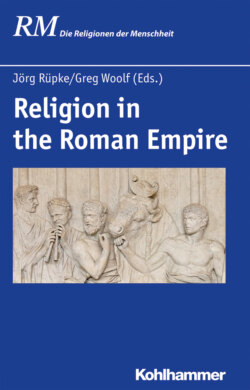Читать книгу Religion in the Roman Empire - Группа авторов - Страница 34
На сайте Литреса книга снята с продажи.
3.1 Space for experience—personal needs and religious experience
ОглавлениеEach individual, if he did not attend large periodic celebrations, naturally came to a sanctuary with individual needs, ideas or desires. What the exact motivation of a person was to involve her- or himself with a deity can be traced in written sources, such as papyri or inscriptions, and ranges from oath formulae (for example to the tyche of the emperor151) to dedications ex voto, whereas in the archaeological material only in the case of individualised forms of dedications a glimpse of an individual motivation can be grasped.152 The countless prayers and acclamations with which she or he communicated with the deities and asked them for support do not find reflections in the archaeological material. If someone wanted to express a wish or thank a god for a good result, she or he could set up a dedication. Such dedications could find their place at home at the household altars or in niches and consists in organic material. But many people brought these dedications and gifts to sanctuaries as places of divine presence and successful communication with the gods. Mass produced motifs, lamps, ceramic vessels and statuettes give insights into the innumerable occasions when wishes and thanksgiving were necessary or appropriate.153 An object with an inscription, bases or vessels that make references to the donating person are rarer, but the consecrations of objects of personal use—such as amulets, jewellery, utensils, etc.—to the deities attest to close personal identification with the act of dedicating. If an inscription states that he or she made the dedication ex voto, ex visu, or kat’ oneiro, it demonstrates that the direct invitation or admonition from the deity was the initial motive. Cartilius Euplus uses this formula in the dedication of the extraordinary Attis statue in the sanctuary of Mater Magna at Ostia.154 The dedicators by materialising these contacts to the gods and the sanctuaries as places for keeping these materialisations mutually confirmed the significance of the place and the rituals and helped to make such experiences of successful communication possible. Every new visitor came across the former consecrations, dedications or traces of religious practices of those who have been there before him or her. In turn, every act of consecrating an object, a plant or an animal, every visit, and every testimony of successful communication with the gods enhanced the credibility and religious suitability of the place.155
The socio-political changes in the Roman Empire coming along with the establishment of a princeps around the turn of the era caused an increasing interest in religion in order to define identities and roles in society. With this, the nature of deities, and how to get close to them, and the nature of religious practices changed insofar as people created parallel societies (Lares Augusti, Mithras), set up their own religious spaces in private houses, and provided the gods with an »autobiographical history« that was enacted in the gatherings (Mithras, Syrian gods). The regulations for admission to such groupings (somehow paralleled to initiations), which might have been necessary to be accepted into such a group, fostered personal attention to and experience with these gods.156 The sacrifices as well as the sacrificial banquet for which many of the small sanctuaries with their side benches were prepared (Mithraea in Ostia, Sacello delle tre navate),157 connected these groups of worshippers closely to the rituals common for other Roman gods.158 The importance of communal meals is reflected in the findings of a Mithraeum in Tienen from the 3rd century A.D. in present-day Belgium: Bones of fish, chicken, piglet, but also jackdaw and hare were found in the small cult area demonstrating the high number of attending persons as well as the gamut of sacrificial animals.159
Also the followers of Christ in the 1st and 2nd century A.D. met in smaller groups and in rooms of private houses. Based on the motifs of furnishings and wall paintings we can detect such meeting places of early Christ-followers in Rome and Ephesus.160 It was not before the 4th century A.D. that the Christian sanctuaries, churches, were erected.161
